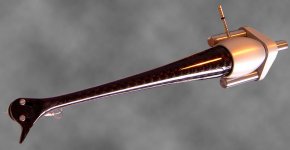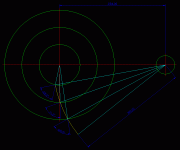analog_sa said:Here's a pic of the Cantus which i still think will make an excellent and easy diy project.
I agree about the easy part, but the engineer in me
has to pipe up its not an ideal shape for a tone arm.
Vertical rigidity is poor, lateral rigidity good, and torsional so-so.
🙂 sreten.
Jerry T. said:Ah, i understand about the tapered arm now,
but how did they fit the bearing in there?
Simple. Its a unipivot. 🙂 sreten.
Attachments
Vertical rigidity is poor, lateral rigidity good, and torsional so-so.
You're absolutely right. Still, i have listened to the Scheu Classic, a cheaper unipivot in the Scheu range and can vouch it is a top performer. The Cantus is supposed to be much better...
The tapered arm is relatively easily cloned.
If anyone's interested ill try to dig out some of the info i have on carbon fibre stocking.
Magura🙂
If anyone's interested ill try to dig out some of the info i have on carbon fibre stocking.
Magura🙂
Magura said:The tapered arm is relatively easily cloned.
If anyone's interested ill try to dig out some of the info i have on carbon fibre stocking.
Magura🙂
Oh, yes please!

Second thought:
If interested, just start a new thread about the tapered carbon arm.
Most of the info i have is no good for the general DIY'er, it assumes quite a bit of experience.
Ill start a thread
Magura🙂
If interested, just start a new thread about the tapered carbon arm.
Most of the info i have is no good for the general DIY'er, it assumes quite a bit of experience.
Ill start a thread

Magura🙂
tapered carbon fiber?
You may find what you are looking for among the parts offered to fishing rod kit builders.
Good Luck
You may find what you are looking for among the parts offered to fishing rod kit builders.
Good Luck
I've started with designing a tonearm, it's going to be about 12" (300mm to be exact) long. I've made this drawing, but am not sure if this is the right way to go! The average angle for the cartridge will be 20.5 degrees.
Could anybody tell me the right geometry for a 12" tonearm?
Could anybody tell me the right geometry for a 12" tonearm?
Attachments
How to draft a tonearm's geometry
Hello Jerry,
1st, look up John Elison's wonderful spreadsheet ; you may also want to read John Elison's remarks to this spreadsheet (just scroll down to the end of the page).
2nd, look up my SME V geometry post in the Vinyl Asylum.
My post has 3 pixes, the 1st of them should be the one interesting to someone designing a pivoted tonearm.
Input parameters of John Elison's spreadsheet are innermost and outermost groove radius a desired effective tonearm length. From that John Elison's spreadsheet calculates a linear offset and derived from that the inner zero radius, the outer zero radius, the overhang and the headshell's effective offset angle.
The real offset angle may differ from that as the relevant effective length is measured from stylus tip to tonearm pivot -- depending on your headshell's shape, the real angle headshell2tonearmwand may differ.
For the usual inner groove of 60.325mm and outer groove of 146.05 we yield a linear offset of 93.445mm, an inner zero radius @66mm and an outer zero radius @120.89 .
In my VA post i used a slightly different linear offset of 93.468 but same inner and outer zero radius as i wanted to have the values perfectly aligned with the specifications of the SME V manual.
To avoid confusion, i would recommend to design your tonearm based on the linear offset: this the distance between groove tangent (if and when the actual radius of stylus location is a zero radius) and its parallel thru the tonearm pivot. For a given set of innermost and outermost groove, this linear offset is a constant and independent of tonearm length.
Needless to say, if you want to align your cartridge along slotted holes or parallel headshell edges, these should be parallel with the groove tangent and the linear offset straight. If you want to move the whole arm (as SME does), you have to bother even less, just align the cartridge along the groove tangent (@ zero radius), draw a parallel straight in
93.445mm distance and you know: your tonearm pivot must be located on this parallel straight. Tonearm length: your choice, then go back to the spradsheet and have the overhang calculated.
You will need this overhang later for aligning tonarm and cartridge: The arc along which the stylus tip is moving has to pass the platter spindle pivot at overhang distance.
So, now you should have everything to solve the problem yourself.
Hello Jerry,
1st, look up John Elison's wonderful spreadsheet ; you may also want to read John Elison's remarks to this spreadsheet (just scroll down to the end of the page).
2nd, look up my SME V geometry post in the Vinyl Asylum.
My post has 3 pixes, the 1st of them should be the one interesting to someone designing a pivoted tonearm.
Input parameters of John Elison's spreadsheet are innermost and outermost groove radius a desired effective tonearm length. From that John Elison's spreadsheet calculates a linear offset and derived from that the inner zero radius, the outer zero radius, the overhang and the headshell's effective offset angle.
The real offset angle may differ from that as the relevant effective length is measured from stylus tip to tonearm pivot -- depending on your headshell's shape, the real angle headshell2tonearmwand may differ.
For the usual inner groove of 60.325mm and outer groove of 146.05 we yield a linear offset of 93.445mm, an inner zero radius @66mm and an outer zero radius @120.89 .
In my VA post i used a slightly different linear offset of 93.468 but same inner and outer zero radius as i wanted to have the values perfectly aligned with the specifications of the SME V manual.
To avoid confusion, i would recommend to design your tonearm based on the linear offset: this the distance between groove tangent (if and when the actual radius of stylus location is a zero radius) and its parallel thru the tonearm pivot. For a given set of innermost and outermost groove, this linear offset is a constant and independent of tonearm length.
Needless to say, if you want to align your cartridge along slotted holes or parallel headshell edges, these should be parallel with the groove tangent and the linear offset straight. If you want to move the whole arm (as SME does), you have to bother even less, just align the cartridge along the groove tangent (@ zero radius), draw a parallel straight in
93.445mm distance and you know: your tonearm pivot must be located on this parallel straight. Tonearm length: your choice, then go back to the spradsheet and have the overhang calculated.
You will need this overhang later for aligning tonarm and cartridge: The arc along which the stylus tip is moving has to pass the platter spindle pivot at overhang distance.
So, now you should have everything to solve the problem yourself.
- Status
- Not open for further replies.
- Home
- Source & Line
- Analogue Source
- DIY arm question


